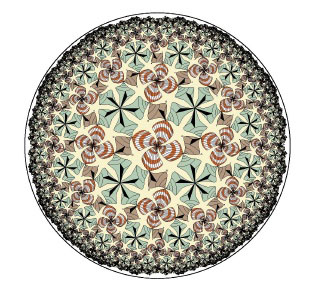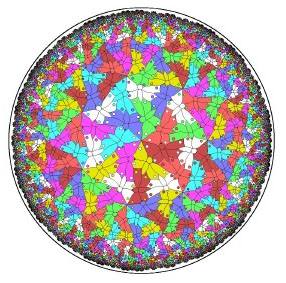Doug Dunham
"Five Equidistant Fish Pattern"
Digital print, 2001

"Four and Five Shells Pattern"
Digital print, 2001

"Seven Butterflies Pattern"
Digital print, 2001

Douglas Dunham has a Ph.D. in mathematics and has taught computer science
at the University of Minnesota Duluth since 1977. His research interests
include creating repeating patterns in Euclidean, hyperbolic, and spherical
geometry, and on other 2-dimensional surfaces.
"One of my main goals is to create more hyperbolic Escher patterns,
as displayed here. I am convinced that if it had not been so
labor-intensive to create hyperbolic patterns by hand, that Escher
would have designed many more such patterns. This becomes much easier
if done by using a computer and color printer, however there are
challenges in designing a computer program to do this. Thus I see
my work as extending Escher's work."
"All these patterns are drawn in the Poincare circle model of hyperbolic geometry.
This model was chosen because it is conformal, and it allows
the entire pattern to be shown (unlike the half-plane model).
Five Equidistant Fish Pattern is based on the fish pattern of Escher's
hyperbolic "Circle Limit III" print in which the fish swim
along (hyperbolic) equidistant curves, except that five fish meet
at a right fin here instead of four fish as in Escher's pattern.
Unlike Escher's pattern which requires only 4 colors, six colors are
required for a perfect coloring of this pattern (with fish of the same
color along an equidistant curve). The color group is isomorphic to
the alternating group A(5).
"Four and Five Shells Pattern is based on the shell pattern of Escher's Euclidean
Notebook Drawing Number 42, except that there are points of both
4- and 5-fold symmetry, whereas there is only 4-fold symmetry in
Escher's pattern. As with Escher's pattern, the meeting points of
scallops, which appear to be 4-fold rotation points (as at the center),
are actually only 2-fold rotation points, as verified by close inspection).
"Seven Butterflies Pattern is based on the butterfly pattern of Escher's
Euclidean Notebook Drawing Number 70, except that points of 6-fold
symmetry have been replaced by points of 7-fold symmetry, making it
a hyperbolic pattern. This pattern requires eight colors for a perfect
coloring and its color group is PSL(2,7), the simple group of order 168.
Note that the butterflies come in `rings' of the same color and the
circular spots on the wings of all 7 butterflies within a ring are the
same color as that ring."
Name: Doug Dunham
Email: ddunham@d.umn.edu
Web: http://www.d.umn.edu/~ddunham/
Address: Department of Computer Science
University of Minnesota Duluth
1114 Kirby Drive
Duluth, MN 55812-3036





